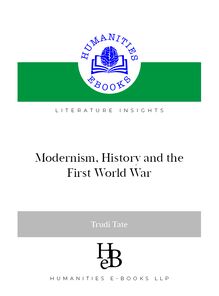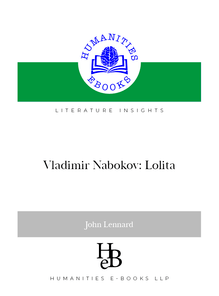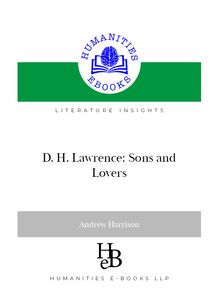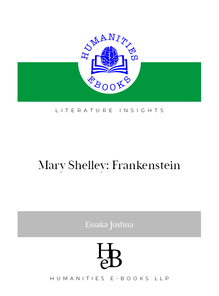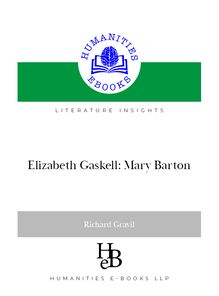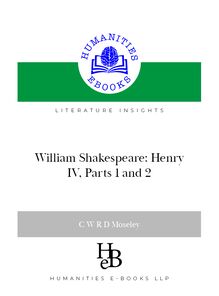-
 Univers
Univers
-
 Ebooks
Ebooks
-
 Livres audio
Livres audio
-
 Presse
Presse
-
 Podcasts
Podcasts
-
 BD
BD
-
 Documents
Documents
-
- Cours
- Révisions
- Ressources pédagogiques
- Sciences de l’éducation
- Manuels scolaires
- Langues
- Travaux de classe
- Annales de BEP
- Etudes supérieures
- Maternelle et primaire
- Fiches de lecture
- Orientation scolaire
- Méthodologie
- Corrigés de devoir
- Annales d’examens et concours
- Annales du bac
- Annales du brevet
- Rapports de stage
La lecture à portée de main
90 pages
English
Découvre YouScribe en t'inscrivant gratuitement
Je m'inscrisDécouvre YouScribe en t'inscrivant gratuitement
Je m'inscris
Obtenez un accès à la bibliothèque pour le consulter en ligne
En savoir plus
En savoir plus
90 pages
English
Obtenez un accès à la bibliothèque pour le consulter en ligne
En savoir plus
En savoir plus

Description
This book shows Mary Barton to be a much more conflicted novel than it is usually thought to be, takes issue with patronizing accounts of Gaskell's views, and promotes her as an author whose grasp of the political and economic issues of the period runs deeper than is usually acknowledged.
Sujets
Informations
| Publié par | Humanities eBooks |
| Date de parution | 11 janvier 2021 |
| Nombre de lectures | 0 |
| EAN13 | 9781847600103 |
| Langue | English |
| Poids de l'ouvrage | 1 Mo |
Informations légales : prix de location à la page 0,0200€. Cette information est donnée uniquement à titre indicatif conformément à la législation en vigueur.
Extrait
Literature Insights General Editor: Charles Moseley
Elizabeth Gaskell: Mary Barton
Richard Gravil
RUNNING HEàD 1
‘our labour’s our capital, and we ought to draw interest on that’
http//www.humanities-ebooks.co.uk FoRadviceonuseoFtHisebookpleasescRolltopage2
publicationdata
© RIChàrD gràVIL, 2007
The Author has asserted his right to be identiîed as the author of this Work IN àCCOrDàNCE wITh ThE cOPyrIGhT, dESIGNS àND pàTENTS aCT 1988.
pUBLIShED ByHumanities-Ebooks.co.uk tIrrIL HàLL, tIrrIL, pENrITh ca10 2Je
Readingandlisteningoptions
*To use the navigation tools, the search facility, and other features of the toolbar, this Ebook should be read in default view. *To navigate through the contents use the hyperlinked ‘Bookmarks’ at the left of the screen. *To search, expand the search column at the right of the screen or click on the binocular symbol in the toolbar. *For ease of reading, use <CTRL+L> to enlarge the page to full screen *Use <Esc> to return to the full menu. *Hyperlinks appear in Blue Underlined Text. To return from an internal hyperlink use the ‘previous view’ button and repeat if necessary. *For a computer generated reading use <View>Read out Loud> licenceandpeRmissions
Purchasing this book licenses you to read this work on-screen and to print one copy for your own use. Copy and paste functions are disabled. No part of this publication may be otherwise reproduced or transmitted or distributed without the prior written permission of both the copyright owner and the pub-lisher. Making or distributing copies of this book constitutes copyright infringe-ment and would be liable to prosecution. Thank you for respecting the rights of the author.
isbn 978-1-84760-010-3
Elizabeth Gaskell: Mary Barton
Richard Gravil
Literature Insights. Tirril: Humanities-Ebooks, 2007
Contents
Part 1. Life and Times 1.1 General Introduction 1.2. Life and Works 1.3Gaskell’s Unitarian Milieu 1.4 The Condition of England 1.5 The Rise of Chartism 1.6. ‘Political Economy’ 1.7 The Woman Question Part 2. Narrative Strategies 2.1 Narrative Voice 2.2 A dual narrative? 2.3 Dialogic Features of the Text 2.4 ‘Faction’: Mary Barton’s merge with history 2.5 Absence 2.6 Murder by Proxy 2.7 Symbolism 2.8 Gaskell’s inuence on Dickens’sBleak House 2.9 Death Scenes and Their Uses Part 3. ReadingMary Barton 3.1 An Account of the Novel 3.2 Some Critical Issues Part 4. Reception 4.1 Contemporaries 4.2 Modern Readings 4.3 Bibliography: 4.4 Websites
Part 1. Life and Times
1.1 General Introduction
It is said inThe Gentleman’s Magazinein 1895 that when Mrs Gaskell tried to per-suade a working man that he should not feel hatred towards the rich, he replied, ‘Ay, ma’am, but have ye ever seen a child clemmed [starved] to death?’ She puts the same question—repeatedly—to her readers in this novel. The gulf between rich and poor was never wider than when Elizabeth Gaskell set out to depict the abyss of working class misery in her novelMary Barton, and since she was writing for the rich, with a desire to engage their active sympathy for the poor, she constantly faces a diplo-matic problem. How can she tell the truth—that extreme poverty is a result of an unjust and exploitative social system—without causing offence? In chapter 3 Gaskell gives a vivid and persuasive sketch of the process of capital accumulation, showing howthe poor weaver sees ‘his employer removing from house to house, each one grander than the last’ while the weaver and his fellows struggle to feed their children. She immediately enters a caveat: ‘I know that this is not really the case ... I know what is the truth in such matters’. But she does not tell us what that truth may be. One may well ask whether the ‘I’ that knows ‘what is the truth’ in this chapter, is the same gUSTàVE dOré,London: A Pilgrimage(1872)as the ‘I’ in the preface to the novel More elegant streets, but the same poverty who says she has ‘tried to speak truth-
Mary Barton 6
fully’, or who presents the truth of extreme working-class suffering in chapter 6 and elsewhere. In many ways, Mary Barton is a deeply unstable text, and its author’s politics remain unknowable. That is undoubtedly part of the perennial fascination of this pioneering industrial novel. Coral Lansbury makes the point very clearly:
Nothing could be more unwise than to regard the authorial ‘I’ of the novels as the voice of Elizabeth Gaskell, particularly in the Manchester novels. There the nar-rator has a tendency to engage in false pleading and specious argument, while the 1 workers demonstrate honesty and commonsense. Despite this assertion, well supported in the argument of Lansbury’s chapter, Elizabeth Gaskell has often been adjudged guilty by modern critics of failing to overcome her ‘middle-class’ limitations. It is sometimes implied that she was wrong to prefer broth-erhood to blood-letting, and that she ought somehow to have arrived at a politico-economic theory capable of explaining the crisis of capitalism, or used her novel to articulate a legislative programme that would have anticipated a century and a half of Liberal and Labour administrations. If, indeed, novelists are ‘conditioned’ by their societies, it is surprising how little space has been devoted to discovering what Elizabeth Gaskell’s milieu might have conditioned her to believe, or what she did, in fact, believe. We do know that she pro-fessed considerable sympathy with the hero of her book. Writing to Mrs W. R. Greg (the wife of an industrialist who wrote a hostile review in theEdinburgh Review) she explained that ‘John Bartonwas the original title of the book’, and that she deliber-ately stressed one side of the question, simply because ‘I don’t feel as strongly (and as it is impossible I ever should) on the other side’ (42). In a much quoted passage she says: Round the character of John Barton all the others formed themselves; he was my hero,theperson with whom all my sympathies went, but the full context is slightly less positive. To continue the quotation: … with whom I tried to identify myself at the time, because I believed from per-sonal observation that such men were not uncommon, and would well repay such sympathy and love as should throw light down upon their groping search after the causes of suffering, and the reason why suffering is sent, and what they can do to lighten it’ (Letters of Mrs Gaskell, ed. J. A. V. Chapple and Arthur Pollard, Manchester University Press, 1966, 42).
1 Coral Lansbury,Elizabeth Gaskell: the Novel of Social Crisis(London: Paul Elek, 1975), 9.
Mary Barton 7
Notice the reservations. Shetriedto identify, at the time. Such men are engaged in a gropingsearch. And there is the implication that if suffering issent[i.e. by God], it may play some part in an inscrutable divine purpose. Moreover, Barton is a class-war-rior, whose conversation is mostly devoted to pointing out the evils done by employ-ers, and as Gaskell says elsewhere: ‘no one can feel more deeply than I how wicked it is to do anything to excite class against class’ (letters 72).
1.2. Life and Works
Elizabeth Gaskell was born in London, in 1810, to William Stevenson and Elizabeth Holland. After her mother’s death, a year later, she went to live with an Aunt in Knutsford. When her father died in 1829 she was taken in by the Reverend William Turner in Newcastle, until in 1832 she married The Rev. William Gaskell, who was then assistant min-ister at Cross Street Unitarian Chapel, Manchester, where he remained throughout his ministry. Manchester’s status in the industrial revolution had led to rapid growth, extremes of wealth and poverty, and unprecedented social problems. Cross Street Chapel was in the front line of developing class tensions, and the Gaskells were in frequent contact both with chapel-going industrialists and Chalk portrait by George Richmond, 1851 with Christian philanthropists and reformers from National Portrait Gallery, London around England and New England. The Gaskells’ îrst literary effort was a jointly composed poem called ‘Sketches among the Poor’, published inBlackwood’s Magazine, 1837. Elizabeth’s îrst three stories (‘Libbie Marsh’s Three Eras’, ‘The Sexton’s Hero’, ‘Christmas Storms and Sunshine’) were published in 1847 under the rather American pseudonym Cotton 2 Mather Mills inHowitt’s Journal. The Howitts, William and Mary, were very much on the radical wing of Unitarian social thought, and backed all kinds of reform move-
2 American, because Cotton Mather was one of the dominant îgures in the early years of the New England colony. He is notorious for his part in the Salem witchcraft trials, the subject of Gaskell’s short story ‘Lois the Witch’. His family emigrated from Liverpool where his grandfather was pastor of Renshaw Street chapel.
Mary Barton 8
ments including Chartism. It was the death of her son that led to her writing her îrst novel,Mary Barton, which she înished in 1847 (her husband proposed that writ-ing a novel might help her to deal with her own grief). In 1850 the family moved to Plymouth Grove, Manchester, where they lived for the rest of her life, except that she travelled extensively, to Germany with her husband and to France and Italy on sev-eral occasions, usually with her daughters. Mary Bartonher notorious among local factory owners, and famous made nationally. It brought her to the approving attention of such writers as Charles Dickens, Harriet Beecher Stowe, Charles Kingsley, Thomas Carlyle, and Charlotte Bronte—who became a close friend and whose biography she published in 1857. In 1850, two years after the appearance ofMary Barton, Elizabeth started contributing to Dickens’s new weekly magazine,Household Words, which took a campaigning stance on numerous issues, including employment laws, industrial relations, the rights of women, and popular education, and she went on contributing to Dickens’s publishing ventures for another thirteen years. In 1853 she published the previously serializedCranfordand the notoriousRuth, in which the eponymous heroine (like Mary Barton) is apprenticed to a dressmaker. Ruth is seduced by a man who îrst meets her when she is on duty as a seamstress at a ball (to repair the gowns of ladies) just as Mary is spotted by Carson when her sisters are visiting Miss Simmonds’s establishment. This brave novel (it is brave because Mary is not just an unmarried mother but is the heroine of the novel) was again deeply controversial among her husbands congregation, but was admired by Dickens, Kingsley, Elizabeth Barratt Browning and Florence Nightingale. Her second industrial novel,North and South(in which the heroine Margaret Hale mixes with employers and workers alike) was published in 1855,after serialization in Household Words. Her biography of Charlotte Bronte was published in 1857, and led to threats of legal action (she had written rather incautiously about who might have been responsible for the moral decline of Charlotte’s brother Branwell Bronte, and for the death of Maria Bronte at Cowan Bridge School). In 1858 she publishedMy Lady Ludlow, and in 1863 her press-gang novel,Sylvia’s Lovers, again notable for the realism of her characters and for its sense of history. Cousin Phillis was serialized in theCornhill Magazine, 1863–64 andWives and Daughterspublished posthumously in 1866, again after serialization in theCornhill. There is a mistaken assumption that Gaskell was somehow rather provincial in her experience and attitudes. In fact, in the course of her writing life she met and corresponded (one might say networked) with a great many writers, especially
Mary Barton 9
women writers, and sustained a surprisingly close relationship with America. This is partly because philanthropic Americans took a great interest in social conditions in Manchester, and played a part in inspiring the Domestic Missions. And partly because her own writing was much admired in America: it inspired Rebecca Harding Davis (one of the îrst writers to deal with an industrial underclass in America, in her Life in the Iron Mills, 1861); and it impressed the most famous woman writer of the age, Harriet Beecher Stowe, the author ofUncle Tom’s Cabin(1852) which sold half a million copies in its îrst decade.Uncle Tom’s Cabindid for American slaves what Mary Bartondid for English wage-slaves. Stowe wrote to Gaskell in May 1856 to introduce an African American (Mrs Webb, the daughter of a fugitive slave) who was visiting Manchester, and she added: ‘I do hope I may be permitted to see you this summer, I hope it is to be in England and somewhere perhaps we may meet—You have made me cry very unfairly over Mary Barton when I bought the book to amuse myself with on a journey—but I bear no malice for that. / With true affection, / Ever yours gratefully, / H. B. Stowe.’ Longer term friendships were with the American publisher James T Fields (who îrst published Rebecca Harding Davis), and with Charles Eliot Norton, later editor of theNorth American Reviewand Professor of Art History at Harvard, who graduated from Harvard shortly beforeMary Bartonwas published. An admirer of her work, and a friend of the family, Norton was Gaskell’s guide to the art treasures of Rome when she visited Italy in 1857 as guest of the American sculptor William Wetmore 3 Story. Elizabeth Gaskell died suddenly in November 1865, shortly after buying a family home in Hampshire for her husband’s retirement.
1.3 Gaskell’s Unitarian Milieu
The key fact about Mrs Gaskell is that she was a Unitarian both by birth and by mar-riage. The Unitarians were, in the main, politically progressive and theologically lib-eral. They denied several important Christian doctrines, including the doctrine of the Trinity (the idea that God is three persons: Father, Son and Holy Ghost), that of the divinity of Christ (they celebrated his humanity instead), Atonement (the idea that Christ died to atone for humanity’s sins), and the notorious doctrine of Predestination.
3 thEIr COrrESPONDENCE IS àVàILàBLE INLetters of Mrs Gaskell and Charles Eliot Norton, ED. JàNE Whitehill (London 1932).
-
 Univers
Univers
-
 Ebooks
Ebooks
-
 Livres audio
Livres audio
-
 Presse
Presse
-
 Podcasts
Podcasts
-
 BD
BD
-
 Documents
Documents
-
Jeunesse
-
Littérature
-
Ressources professionnelles
-
Santé et bien-être
-
Savoirs
-
Education
-
Loisirs et hobbies
-
Art, musique et cinéma
-
Actualité et débat de société
-
Jeunesse
-
Littérature
-
Ressources professionnelles
-
Santé et bien-être
-
Savoirs
-
Education
-
Loisirs et hobbies
-
Art, musique et cinéma
-
Actualité et débat de société
-
Actualités
-
Lifestyle
-
Presse jeunesse
-
Presse professionnelle
-
Pratique
-
Presse sportive
-
Presse internationale
-
Culture & Médias
-
Action et Aventures
-
Science-fiction et Fantasy
-
Société
-
Jeunesse
-
Littérature
-
Ressources professionnelles
-
Santé et bien-être
-
Savoirs
-
Education
-
Loisirs et hobbies
-
Art, musique et cinéma
-
Actualité et débat de société
- Cours
- Révisions
- Ressources pédagogiques
- Sciences de l’éducation
- Manuels scolaires
- Langues
- Travaux de classe
- Annales de BEP
- Etudes supérieures
- Maternelle et primaire
- Fiches de lecture
- Orientation scolaire
- Méthodologie
- Corrigés de devoir
- Annales d’examens et concours
- Annales du bac
- Annales du brevet
- Rapports de stage
Signaler un problème
YouScribe
Le catalogue
Le service
© 2010-2024 YouScribe
